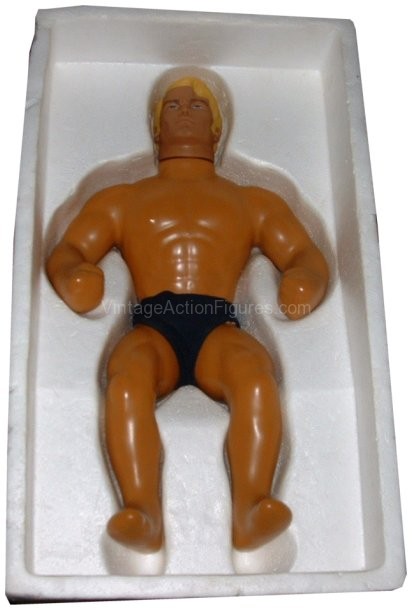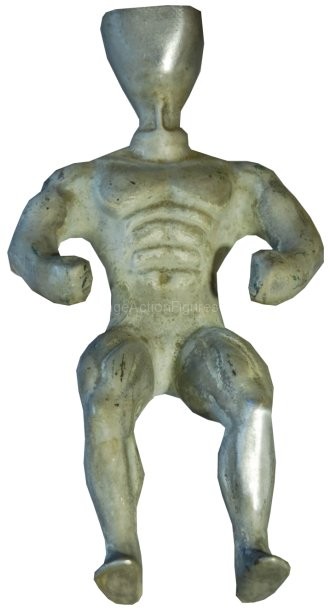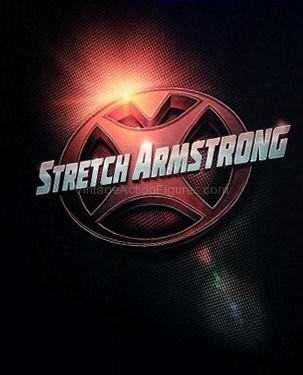
In 1974 a new idea blossomed in the action figure arena. From the imaginative mind of a Kenner employee a new type of figure, Stretch Armstrong, was born. He was no ordinary action figure. He was filled with corn syrup and his arms and legs could stretch to almost four times their original size. Children of the world responded with such enthusiasm that Stretch Armstrong eventually became a toy icon.
The creative Kenner employee’s name was James Kuhn and he developed the basic idea of the stretch figure into something that was accepted by Kenner management for production. Once the figure was sketched out, the technical drawings were then sent to Kenner’s tooling companies so that the molds could be made. The molds, also called mandrels, were made from either aluminum or ceramic. The molds were then dipped in latex to create the figures skin. The ceramic molds produced a smoother skin with more muscle definition than did the aluminum molds. But, the aluminum molds were easier and faster to make so most figures were eventually made with this process.

Once the skin was made it was filled with what is basically corn syrup mixed with a few other ingredients to reduce the moisture content and make it more malleable. Still, if Stretch Armstrong was injured in a “fight” he would bleed sweet corn syrup. Of course, over the years the syrup mixture would either leak or become hard rendering poor Stretch a lot less stretchy.
At that point a hard plastic neck insert was placed in the neck cavity of the figure. A rubber o-ring was then used to compress the plastic skin onto the neck piece. Years of torturous play and aging led many a Stretch Armstrong to leak in this area. It can be seen pretty readily by the dark brown ring around a lot of the Stretch Armstrongs necks. Once the Stretch was filled with the syrup mixture another neck insert was placed in the neck opening that had a small hole that was used to bleed the air from the figure. With all the air out of the figure the hole was then sealed with glue. Armstrong’s head was then placed over a flange on the neck insert. The head slipped over the flange and was made of a softer rubber so it could expand over the flange and was held in place by extrusions on the inside of the head/neck. Once finished Stretch got a dousing of talc powder to keep his skin in nice condition. Stretch Armstrong now lives! Unfortunately for him he was then placed in a Styrofoam coffin and then into the retail box. The Styrofoam coffin conforms to the stretch body so he fits in it like a glove. So, Stretch can not only survive extensive stretching of his limbs but can withstand long periods of time in a small claustrophobic Styrofoam coffin as well.

While you may currently be floating on a cloud of whimsical nostalgia remembering your younger carefree days and hours of playing with your Stretch Armstrong let me bring you back to earth with the actual patent language from the original Stretch Armstrong patent filed in 1977. In the patent, Stretch was actually called a “Stretchable figure exhibiting slow recovery”. Not an appealing name for a children’s toy. The patent description said:
The present invention provides a toy figure of any desired shape. For example, the toy figure may be a doll in the shape of a muscular man or a shapely woman. The toy figure may alternatively be in the form of an animal shape such as a giraffe, an elephant or a pig. In each instance, however, the figure will include an elastic skin having a memory and a highly viscous filling material.
The skin material may be any elastic film material having a memory. Suitable material includes natural rubber, as well as synthetic rubber. The elastic film is first formed into the desired shape such as the shape of the human body or that of an animal body. This skin manufacturing process may be carried out in a manner similar to that used in preparation of shaped expandable balloons. Desirably, this elastic skin has elongation characteristics permitting stretching of at least 300 percent of its original dimensions and yet returning to its original dimensions upon release. It also has characteristics that permit repeated stretching and distorting. An important characteristic of the skin is its capability of stretching while under stress and returning to its original size upon release of the stress.
What was Stretch Armstrong filled with? What did he bleed when gored by Stretch X-Ray? Well, he bled high viscosity corn syrup. Kenner probably mixed a number of other ingredients with the corn syrup in order to increase its viscosity. In fact, the patent mentions nine different formulations of potential corn syrup recipes. Viscosity is basically a measure of a liquids thickness. Regular corn syrup is thicker than water but probably not thick enough for Stretch Armstrong so Kenner basically took the corn syrup and cooked it for a little bit to remove some of the moisture which in turn made it thicker. Then they possibly added some other inert ingredients like limestone, rosin, or pine pitch to increase the viscosity and weight even more as well as reduce costs.

Sadly, Stretch Armstrong was made to be brutalized by kids and despite his toughness he many times did not survive the ordeals that children put him through. Because of this, there are not that many Stretch Armstrongs left in the world and very few in excellent condition. There were roughly 40 thousand Stretch Armstrongs made when production began in 1976, but since so many did not survive there are estimates of only a few hundred in existence today. Of those few hundred perhaps less than 50 are in very good or better condition. Of course, over time more Armstrongs will be found and that number will go up but not by much. The popularity of the figure as a collectible will most likely grow far faster then the supply possibly can.
Stretch is about 15 inches long and can be stretched to nearly four feet. Included in the retail box were 10 Curad bandages which could be used to patch any leaking punctures that Stretch may suffer. A stretch graph or poster was also included which showed how far Stretch could be extended. The Stretch poster is attainable for collectors but the bandages are extremely difficult to find. Obviously most kids would either use the bandages to fix Stretch or they would lose or throw them away.
As far as I know, the original Stretch was issued in two different boxes. One was the box you will usually see him in which looks like this:

There was also a far more rare window box that looks like this:

This box is a copy of the original design (of which there are less than a handful in existence). The Stretch King sold this copy box along with an Armstrong figure for over $900 in May of 2013. The Stretch king is probably the leading unofficial authority on Stretch figures and has a massive collection of the rarest stretch figures known to exist. He has been slowly selling them and you will see some of his items on eBay from time to time. In fact, at the time of this posting he was selling this cool ceramic Stretch Armstrong mold for over $2800.00. The ceramic or porcelain mold, also called mandrels, are very rare since they are so fragile and crack very easily.

There is also a more common aluminum mandrel like this:

There are a number of different versions of Stretch Armstrong and he was marketed all around the world. The Japanese version of Stretch Armstrong is called Mister-X and looks like this:

As you can see the figure is essentially the same but the box artwork and name are different. Mee-Sue-Tah-X!
Here is the Stretch poster or graph that kids could use to measure their Armstrong’s stretching capacity:

There were quite a few related Stretch figures made such as Stretch X-Ray, Stretch Monster, and the extremely rare Stretch Serpent. Later in 1993, Stretch was revived by Cap Toys and re-issued with a new design as well as a sidekick dog named Fetch Armstrong and evil counterpart called Wretch Armstrong.

As you can see, the Cap Toys Stretch has a more exaggerated comical face and sports shorts and shirt with logo.
Apparently there is a movie in the making featuring Stretch Armstrong. Hasbro, which currently owns the rights to Armstrong, signed a deal with Universal Studios to make the film which was originally going to star Taylor Lautner as Stretch but he has since dropped out. Universal then dropped the film but is was picked up by Relativity Media and filming began in May of 2013.

The film is scheduled for release in April of 2014. The media and public exposure of Stretch should push values of the older figures even higher.
It’s already very difficult to find the original Kenner version of Stretch Armstrong in anything better than good condition. Most examples have damage or signs of age of some sort or another. The highest sale value I’ve seen has been one of the Stretch King’s which sold for $3,750. That Stretch was in mint, like new condition as was the box. It even included the nearly impossible to find bandages. That sale would be the very high end of the spectrum for Stretch Armstrong values. Another sold for $400 but had extensive damage to the box and coffin. There was also a sale of a very nice Stretch with a non-original copy box but with coffin and stretch poster that reached $340 on auction.
There is no doubt that the original Kenner Stretch Armstrong will increase in value over time. There are only so many of them left and even those are probably deteriorating to some extent if not properly stored and maintained. So, if you want a Stretch you’d probably better find one fairly soon.
If you want to learn more about Stretch Armstrong and his cohorts be sure to check out the Stretch King’s site at Stretch Armstrong World. It’s a great site with basically everything you’d ever want to know about Stretch.


